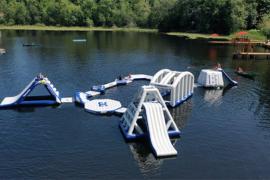The transportation of kids, equipment, and supplies at camp plays a large role in the success of camp each summer. Going on field trips and participating in other off-site activities contributes to the fun and exciting aspect of camp, while also presenting significant risk to campers and staff.
Each year, when Redwoods analyzes our most frequently reported incidents, auto accidents are always high on the list. Specifically, vehicles striking other vehicles, or other objects, while backing up.
A few examples of these "backing-up" accidents include:
- While maneuvering to park at a field trip destination, a driver misjudged the distance and accidentally collided with a parked vehicle.
- After successfully delivering supplies to the camp wellness center, a driver had trouble backing up on camp property, ultimately striking a tree.
- While transporting a trailer loaded with kayaks, a driver inadvertently struck a pole positioned to guide vehicles into the lake entrance.
By understanding the potential impacts and recognizing the causes of transportation accidents, your drivers can take proactive measures to enhance safety and minimize the risk of an accident this summer.
Disrupting Your Camp’s Mission
The majority of auto accidents reported to us did not result in anyone getting injured. And while this is positive, these accidents can have far-reaching consequences.
At the heart of every camp's mission is creating a safe and nurturing environment for all its campers. Whether it's staff, children in the vehicles, or other community members on the road, any accident — no matter how minor — has the potential to cause injury and instill fear. Such accidents can deeply impact the emotional well-being of campers, disrupting their sense of safety and security at camp.
Beyond the immediate safety concerns, these vehicle accidents can also disrupt your camp programming. If a vehicle is out of commission, it can impact your ability to transport kids to programs, or impede other transportation needs. In today's environment, where vehicle repair and replacement is prolonged, it can take time for your vehicles to be back up and operating after an accident.
This is why it is important that your camp is taking every step possible to set your drivers up for success when they are behind the wheel. And it is just as important that your drivers understand the potential consequences if an accident were to occur.
Driving in Today's World
Several key factors play a significant role in these accidents, ranging from the demographics of camp staff to the technology integrated into camp vehicles. Below are some of the most influential factors:
- Camps often employ young individuals, who may have limited experience on the road and with driving in general.
- Many drivers are accustomed to vehicles equipped with advanced safety technology, such as backup cameras, which can lead to overreliance on such features.
- Camp vehicles may differ significantly from drivers' personal vehicles, requiring adjustment to operate them safely.
- The presence of children in the vehicle can create distractions, further increasing the risk of accidents. Cell phones and other technology are also one of the leading distractions while driving and can cause driver's eyes, hands, and mind to be off the road.
- Staffing challenges in past years may have contributed to high staff turnover leaving your camp to have new drivers, or fewer drivers.
Making your drivers aware of these contributing factors is the first step. Providing training and implementing procedures that support them is how you, as camp leadership, can set your drivers up for success.
Selecting Drivers with Precision and Care
Selecting the best drivers to operate your vehicles is the first step in safety. The Redwoods Group has a Driver Selection and Control tool that will help you evaluate whether an employee would be a good fit as a driver for your organization. This primarily focuses on a driver's age, driving experience, and history with traffic laws and accidents.
Once you have selected your drivers, you will want to complete a skill verification. This allows you to assess their knowledge and specific driving skills, and then remediate where needed. Download The Redwoods Groups sample Driver Skill Verification tool as a guide for various items to evaluate when taking a driver out on the road for the first time.
Fostering a Culture of Safety Behind the Wheel
Selecting safe drivers — and verifying their skills — is just the first step, however. Just like we do with our lifeguards, our camp drivers need ongoing training and skills development opportunities. This allows them to apply their knowledge to situations they may face while at work, and practice their skills in real-life scenarios.
Scenario-Based Training
Scenario-based training is essential for preparing drivers to handle various situations they may encounter during the camp season. By simulating real-world scenarios beforehand, drivers can practice without feeling overwhelmed by the responsibility. Some examples of scenarios to include in training sessions are:
- Driving around camp to familiarize drivers with camp routes and conditions.
- Practicing driving in different weather conditions, such as strong winds or rain.
- Navigating highways and traffic safely.
- Conducting practice runs to the airport for picking up campers.
- Driving to, and parking at, all field trip locations.
Identify and plan for all scenarios drivers may encounter at your camp and develop a training plan accordingly.
Back-Up Practice
Given that backing up is a leading cause of accidents, implementing specific safety practices for backing up is crucial. Consider the following ideas:
- Transportation Rodeo: Host a transportation rodeo featuring different skills tests, such as backing up without hitting obstacles, like cones. This engaging activity allows drivers to test their skills while having fun.
- Orange Cone: Implement an orange cone policy where drivers must place cones at the front and rear of the vehicle after parking. This encourages drivers, while leaving and removing the cones, to intentionally check their surroundings before backing up.
- Utilize Other Staff: Utilize other staff members to assist during backing-up practice sessions, either from inside the vehicle or by providing guidance outside (if can be done safely). Having an extra set of eyes can enhance safety and reinforce proper backing-up techniques.
"Drive-Alongs" with Leadership
Implementing "drive-alongs" with camp leadership is an effective method to develop drivers' skills. Not only does this provide drivers with valuable behind-the-wheel experience, but it also offers leadership the opportunity to provide guidance and reinforcement of safe driving behaviors. These ride-alongs should continue throughout the summer, allowing leadership to monitor drivers' performance and ensure consistent adherence to safety protocols, especially when campers are present in the vehicle.
Please Note: Telematics apps have evolved significantly, enabling employers to monitor vehicle movements, speed, and various metrics like "hard stops" and "rapid acceleration.” While these apps offer valuable insights, their effectiveness depends on consistent tracking and utilization of the data. Discovering post-accident that a driver consistently exceeded speed limits is unhelpful. Therefore, organizations employing such technology should establish clear policies and protocols to actively monitor and enforce accountability among drivers.
By incorporating these strategies into your driver training program, you can enhance the skills and preparedness of your drivers, ultimately reducing the risk of accidents at camp.
This blog is sponsored by The Redwoods Group — a mission-driven insurance carrier that only insures camps and other youth-serving organizations. Redwoods' model leverages data and insights from its insuring relationships to help customers scale their mission, protect their campers and create safe communities for all.
Photo by Rodrigo dos Reis on Unsplash.
Periodically, the American Camp Association (ACA) makes timely and relevant information about products and services available to its members so they can make informed decisions for their camps. However, the ACA does not endorse products, services, or companies.




